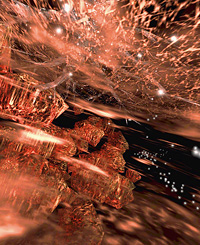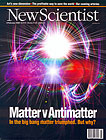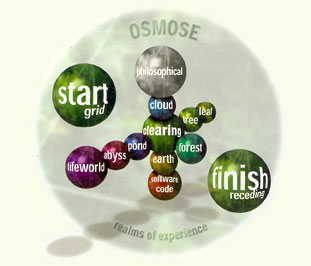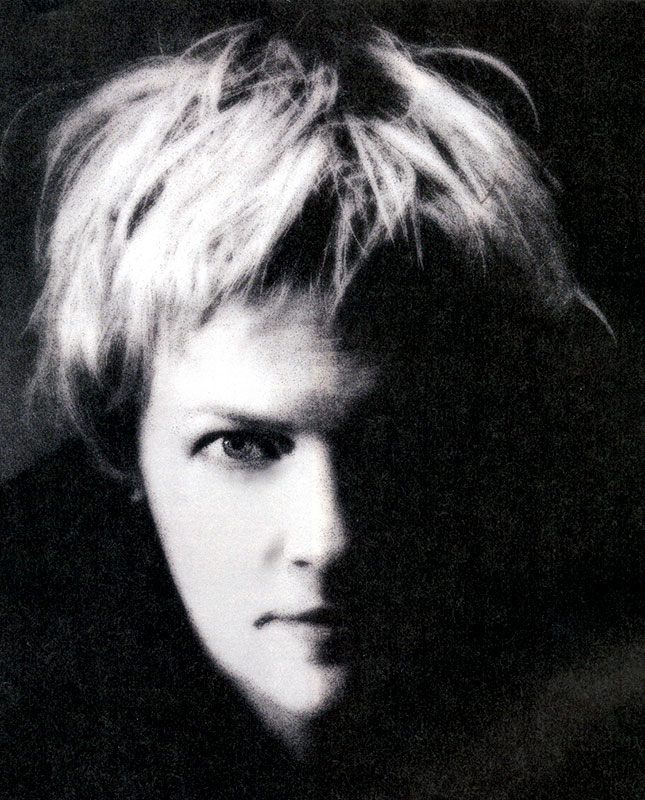Two dimensions weren't enough for artist Char Davies.
She swapped her paintbrush for a supercomputer.
Margaret Wertheim explores her virtual masterpieces.
"I think that by using a fully enveloping virtual environment, one can get closer to re-creating the sensation of being," says Char Davies. And that sensation of being is what Davies is all about. Originally a painter, she is now widely acknowledged as one of the world's leading virtual reality artists. In her worlds, things that we take for granted—gravity, flat surfaces and that walls are hard—can no longer be relied on. "I release people from those physical constraints and allow them to experience 'being' in a slightly different way," she says. "It almost refreshes their perception, so they can rediscover what it feels like to be here when they come back out into the world."
Davies has succeeded in pushing the boundaries of experience to a remarkable extreme. Last summer, at the National Gallery of Canada in Ottawa, she unveiled her most recent work, the semi-abstract, semi-transparent Ephémère. In this virtual world, through which people navigate simply by breathing and shifting their centre of balance, Davies uses state-of-the-art 3D graphics and sound to create an experience of stunning beauty.
With high-end image processors costing several hundred thousand dollars, few artists outside the film and advertising industries can afford to work on the latest VR technology. But Davies is no ordinary artist. She set aside her painting career to spend ten years with the Montreal-based company SoftImage, which is now a leading supplier of graphics software to film makers. When she joined in 1987, the company had just three employees, and as a director and vice-president of visual research, she helped to launch the firm on a meteoric rise.
SoftImage's success has given Davies enough money to do as she pleases. And rather than return to brush and palette, she chose instead to work with a Silicon Graphics Onyx2 supercomputer, the Rolls-Royce of graphics processors. This decision was not an artistic about-face, she insists, but an evolutionary progression. "I used to want to step into my paintings, past the canvas. I wasn't interested in working with a space that relied on a flat surface," she says. "I wanted to give people a sense of being themselves embedded in an enveloping, flowing space."
In the 1980s, she explored three-dimensional computer graphics as a way of fulfilling this desire, but when her images were reproduced as 2D photos, they too lost their 3D feel. Virtual reality seemed the best solution. Only in the past couple of years, she says, have graphics computers become capable of rendering the types of effect she seeks.
Davies's worlds are not only visually unique, they are breathtaking in their technological sophistication. Like no other VR experience, they give you the feeling of really being immersed in "another reality".

Char Davies, Forest grid, from Osmose, 1995
Digital image captured in real-time
through head-mounted display during
live performance.
Her first world was Osmose. It propels "immersants" through a cartesian grid and into a phantasmagoric luminescent forest. They find themselves in a clearing with a great old oak in the middle. Everything here seems to be constructed of light. Tree trunks, branches and leaves shimmer with a strange phosphorescence, while in the distance there appears a river of dancing lights. The whole effect is stunningly beautiful and the image resolution extraordinary. The air is filled with vaguely organic, though distinctly electronic, sounds. It is almost as if this digital forest were alive.
What people do in Osmose is entirely up to them. Unlike most computer-based worlds and games, there are no quests to pursue or puzzles to solve. The whole point, Davies says, is that people should explore the space in their own time and way, simply enjoying the experience.
Moving through Osmose is itself an experience, for Davies has rejected the joystick as navigational tool. Instead, people control their motion by breathing and shifting their centre of balance. As well as wearing a stereoscopic VR helmet, people entering Osmose strap on a chest harness fitted with sensors that detect movements of the torso. To travel forwards you lean forward, to move backwards you lean back, and so on. The harness relays what it senses to the Onyx processor, which recalculates the image with lightning speed and moves it in the correct direction.
Bodiless exaltation
But in Osmose, moving horizontally is not the only option. If you want to go up, you simply breathe in—the harness senses your chest's expansion. Breathing out takes you down. "The idea of working with breath fascinated me," says Davies. Shifting away from manual control was a key decision for Davies. A joystick gives people the feeling that they are operating something, while the harness makes them part of that thing. "I think it emphasises being rather than doing," she says.

Char Davies, Tree Pond, from Osmose, 1995
Digital frame captured in real-time through head-mounted display during live performance.
In his novel Neuromancer, William Gibson famously championed "the bodiless exaltation of cyberspace". But Davies does the opposite. She works hard to "reaffirm the presence of the body in cyberspace". It's an experiment that works well: manoeuvring through Osmose using bodily movements is one reason why this virtual experience seems so uncannily "real".
Osmose is not one virtual environment but a number of them (see Diagram below). Each one is reached by moving in a different direction away from the forest clearing. Moving horizontally, you are engulfed by huge floating, opalescent leaves. Here on the forest floor, as it were, you are subjected to an insect's-eye view of the world. Downwards, you enter a subterranean world of glowing red rocks—like some cave deep within the Earth. Below this, you reach at last the "bottom" of Osmose, where Davies has created an environment entirely made up of blocks of glowing green computer code. This virtual world is literally "grounded" in the code from which it is created.
Elsewhere, you can travel along the river of lights, which is like being swept along with a great swarm of fireflies. You can step into the heart of the oak tree and see its blood-red sap coursing around you, and you can immerse yourself in a pool of shimmering surreal water.
Organic feel
Osmose's organic environment sets it apart from the overtly "techno" settings of most VR worlds. Gone too is the hard-edged geometry so typical of computer games and virtual worlds. But perhaps most special of all is that Davies wanted the objects in this world to be semi-transparent—a requirement that presented enormous technical challenges for both hardware and software.
Davies experimented with transparency in her paintings and still images on a computer. "I would cast shadows through a semi-transparent texture and the shadows would project onto other semi-transparent textured objects, and so on," she says. To achieve that transparency in her VR world, Davies hired John Harrison as part of her SoftImage team, to develop programs to mesh with the company's modelling and animation software. He faced a huge challenge.

Char Davies, Subterranean Earth,
from Osmose, 1995
Digital image captured in real-time
through head-mounted display during live immersive journey/performance.
"If you want to be able to see through objects in a virtual environment, then the computer has to be able to keep track of, and process, multiple layers of imagery at once," Harrison says. And the more layers you want, the faster the processor you need. To give a feeling for the scale of the task, building one of Davies's still images would take a computer 30 hours. Yet to create smooth motion in a virtual world, the supercomputer needs to generate about 30 frames a second.
Harrison's solution exploits the Onyx's ability to draw pixels at a fantastically high rate, which is used to feed very high resolution monitors. But virtual reality uses lower resolution monitors, so Harrison tweaked the system so he could redraw a single VR frame several times in the time it took to draw a single high-resolution frame. If he wanted 10 layers of transparency, he simply drew over every pixel 10 times.
Osmose received high praise at its premiere in 1995. With Harrison and digital animator Georges Mauro, plus sound composer Rick Bidlack and sonic architect Dorota Blaszczak, Davies had created a virtual experience far beyond anything else in existence. But already she was planning her next work. In Osmose, although you can explore the world in your own way, the environment itself does not change. Davies wanted to create a VR environment that would respond in real-time to the immersant's presence and actions. In her new world, Ephémère, objects within the world "sense" your presence and respond with subtle movements and changes of sound.
Other worldly
Where Osmose has many environments, Ephémère has only three—landscape, earth and body—and all are far more abstract and surreal than the realms in Osmose. Here, again, people navigate using the chest harness. But the "other worldly" feeling is far more intense.
Ephémère also has its own time. As you travel through the world, the landscape passes through day and night, as well as four "seasons", starting with winter, then spring, summer, and finally autumn. As the seasons pass, the three environments change their appearances and different things happen.

Char Davies, Seeds, from Ephémère, 1998
Digital image captured in real-time
through head-mounted display during live immersive journey/performance.
The experience of Ephémère is so abstract that it is hard to describe. At times you appear to be underground amid strange rocky forms. And elsewhere there are bone-like forms, and microbe-like forms with "tails" that flicker gently as you approach. Throughout are enigmatic rivulets of lights. The overwhelming feeling is of being on a planet on the cusp of life. The British scientist James Lovelock once described Earth 4 billion years ago as "a world itching to be alive", and that seems a pretty fair description of Ephémère.
This organic feel is reflected in the sounds of this world. Though they are totally unrecognisable, Bidlack conjured them all from digital recordings of natural sounds and stringed instruments. There is a strong element of interaction too. Blaszczak has positioned sounds at different points in the environments using an "acoustatron", which creates a three-dimensional sound stage around the immersant ("Hear me, see me, feel me", New Scientist, 7 November 1998, p 36). Some of these are triggered to play by the actions of the immersant. "You'd hear one sound when you looked that way," says Davies, pointing. "Or this sound would call you to get your attention, and then something visual would happen."
If Ephémère has a more primeval feel than Osmose, technically it has taken a giant leap forward. The image quality is much finer. Objects are rendered in greater detail and the effect of transparency is more subtle. Moreover, the whole space seems much larger. Where Osmose is decidedly intimate, Ephémère is epic in scale. But processing speed is still a problem, Davies admits. Though Ephémère runs on an upgraded machine and its software has been optimised, "I keep putting more stuff in there," she says.
So far, Ephémère has been shown only in Canada, though Osmose travelled to Canada, the US, England and Mexico. Davies is inundated with requests for exhibitions from around the world, but the cost of staging the experience is still a hurdle. In time, Davies expects that cheaper computers will become powerful enough to run high-resolution VR software, and other artists also will be able to work in the medium. Eventually, she believes, people will be able to access the technology from their homes.
Davies is worried that once this happens, and VR environments proliferate, people will forget about the need to protect the natural environment around them. She is also under no illusions about the uses to which VR will be put—top of the list are computer games and pornography. "I have two options. I can either give up and say it's all going to hell, or I can remain engaged with this technology," she argues. "To remain engaged, you must have the hope that you and other people who have like-minded sensibility will be able to create alternative currents that offer something different from mainstream applications. These seem to be highly reflective of our society today in terms of the violence, aggression and speed, speed, speed."
When that harsh reality gets just too much, it will be a shame if in future there is not somewhere to run—somewhere to at least refresh your sensation of being.
This article may include minor changes from the original publication in order to improve legibility and layout consistency within the Immersence Website. † Significant changes from the original text have been indicated in red square brackets.


